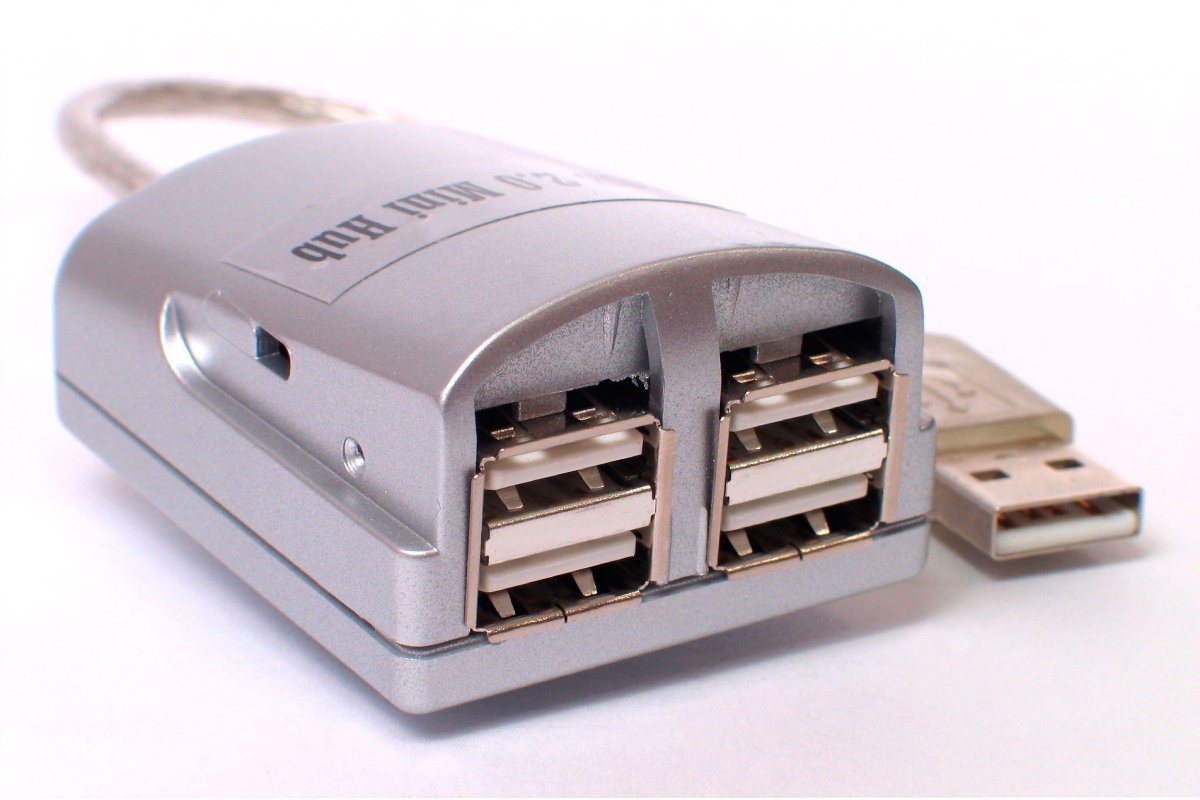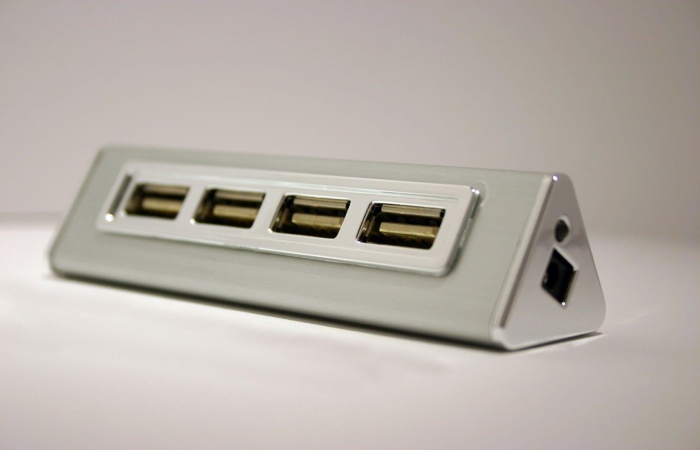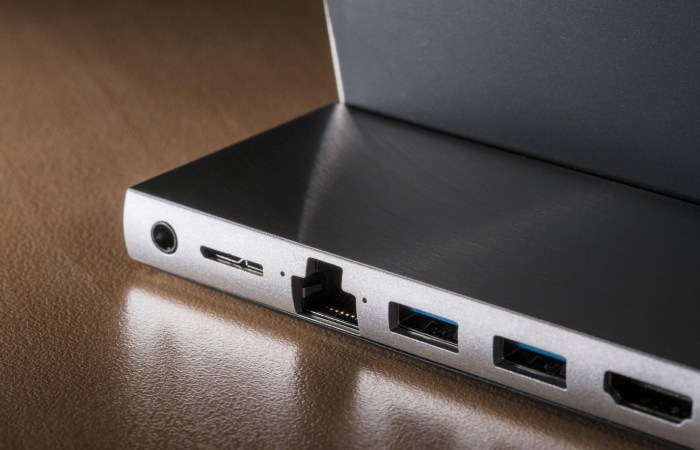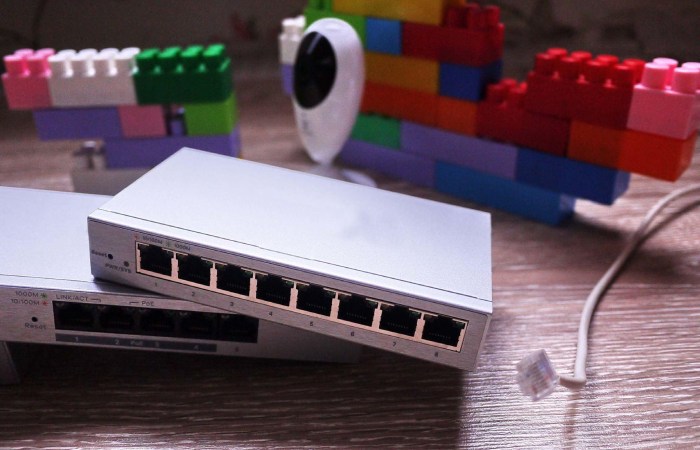A typical port hub has many USB ports on one side and a single USB cable on the other that connects to the host device. When you plug a USB device into one of the ports on the hub, it establishes a connection with the host device and allows data transfer between the two.
Port hubs come in various configurations, such as 4-port, 7-port, or even larger ones, and they can support different USB standards like USB 2.0, USB 3.0, or USB 3.1, depending on the model. Some hubs also have additional features like power adapters to provide sufficient power to connected devices or individual power switches for each port to turn them on or off.
What Is Port Hub?
A port hub, network hub, or Ethernet hub is a networking device that permits multiple devices to connect and communicate over a local area network (LAN). It is a central point for data transmission and reception within a network.
In computer networking, a port hub operates at the OSI model’s physical layer (Layer 1). It contains multiple Ethernet ports where devices like computers, printers, and switches can be connected using Ethernet cables. When a device sends data, the hub broadcasts it to all other connected devices, regardless of the intended recipient. This is known as a broadcast domain.
Port hubs differ from switches in terms of their behaviour. Unlike a switch, a hub does not examine the destination address of incoming data packets to determine the appropriate port for forwarding. Instead, it simply broadcasts the data to all ports, resulting in potential congestion and collisions on the network. As a result, switches have largely replaced port hubs, which provide better performance and efficiency in modern networks.
It’s important to note that the term “port hub” can also refer to a USB hub, as mentioned in my previous response. USB hubs allow multiple USB devices to be linked to a single USB port on a computer. This port hub expands the number of available USB ports and allows simultaneous connections of USB peripherals.
The Key Features and Benefits of Using Port Hub
The key features & benefits of using a port hub, specifically a USB hub, include:
- Expanded Connectivity
- Convenience and Organization
- Simultaneous Device Usage
- Plug-and-Play Functionality
- Data Transfer Speed
- Power Management
- Flexibility and Mobility
Overall, it offers increased connectivity, convenience, and organization, enabling you to connect and use multiple USB devices simultaneously. It simplifies the management of your peripherals, reduces cable clutter, and enhances productivity in various settings, including home, office, or while travelling.
Top 10 Reasons Every Business Needs Port Hub
Increased Device Connectivity
A port hub allows businesses to connect multiple USB devices to a solo USB port on a computer or laptop. This lets employees simultaneously use peripherals such as keyboards, mice, printers, scanners, and external storage devices, boosting productivity and efficiency.
Workspace Organization
Businesses can keep their workspaces neat and organized by using a port hub. Instead of having cables cluttering the desk and tangling together, a hub provides a centralized location for connecting and managing multiple devices, leading to a cleaner and more professional-looking workspace.
Flexibility and Scalability
As businesses grow, their need for additional devices and peripherals increases. A port hub offers flexibility and scalability by expanding the number of available USB ports. It allows businesses to easily add more devices without needing additional USB ports on the computer or the hassle of swapping cables.
Cost-Effective Solution
Investing in a port hub is more cost-effective than purchasing multiple computers or laptops to accommodate additional USB devices. It allows businesses to maximize the usage of existing hardware and resources while still meeting the growing connectivity demands.
Simultaneous Device Usage
Employees can connect and use multiple USB devices with a port hub. This means they can work efficiently by simultaneously accessing and utilizing different peripherals, enhancing productivity and multitasking capabilities.
Collaboration and Sharing
A port hub enables employees to easily share and collaborate in a collaborative work environment using shared USB devices. For example, multiple team members can access and use a printer connected to the hub, streamlining document printing and sharing processes.
Easy Maintenance and Troubleshooting
A port hub simplifies the process when a USB device encounters an issue or needs troubleshooting. Instead of unplugging the device from the computer, employees can conveniently disconnect it from the hub, allowing for easier maintenance and minimizing disruptions to their workflow.
Portability and Mobility
Port hubs are generally compact and lightweight, making them portable and easy to carry. This is particularly beneficial for businesses with mobile workforces or employees who frequently travel. A portable hub ensures employees can connect their USB devices wherever they go, whether in the office, at a client site, or during business trips.
Improved Data Transfer Speeds
USB hubs are available in different versions, including USB 3.0 and USB 3.1, offering faster data transfer speeds than older versions. This is advantageous for businesses that frequently transfer large files between devices or rely on high-speed data access, such as video editing or data backup tasks.
Future-Proofing
Investing in a port hub ensures compatibility with current and future USB devices. As USB technology advances and new devices with higher standards are introduced, a hub that supports the latest USB specifications allows businesses to seamlessly connect and use these devices without needing hardware upgrades.
Overall, it is a valuable tool for businesses of all sizes. It provides increased connectivity, flexibility, and organization, enabling employees to utilize multiple USB devices efficiently. It has become an essential asset in any business environment by simplifying device management and enhancing productivity.
How Port Hub Streamlines Operations
A port hub, specifically a USB hub, can streamline operations in several ways within a business environment:
- Enhanced Connectivity
- Improved Productivity
- Simplified Device Management
- Cable Management
- Collaboration and Sharing
- Flexibility and Scalability
- Streamlined Maintenance and Troubleshooting
- Mobility and Portability
- Future-Proofing
- Resource Optimization
Overall, it streamlines operations by simplifying device management, reducing cable clutter, enhancing connectivity, and promoting productivity. It provides flexibility, scalability, and ease of maintenance, contributing to a more efficient and organized work environment.
FAQ: Frequently Asked Questions About Port Hub
Q1: What is the difference between USB and Ethernet hubs?
A USB hub is a device that enlarges the number of USB ports available on a computer or other host device, allowing multiple USB devices to be connected simultaneously. An Ethernet hub, on the other hand, is a networking device that permits multiple devices to connect and communicate over a local area network (LAN). While a USB hub is used for USB device connectivity, an Ethernet hub is used for network connectivity.
Q2: Can I connect a port hub to a port hub?
It is possible to connect a port hub to another, but it may have limitations. Each hub has a finite number of ports, and connecting multiple hubs in series may result in reduced data transfer speeds or power limitations. It is generally recommended to connect devices directly to the computer’s ports whenever possible and use a hub when additional ports are required.
Q3: What is a powered port hub?
A powered port hub, also known as a self-powered hub, has its own power supply or power adapter. This allows the hub to provide power to connected USB devices, especially those that require higher power consumption, such as external hard drives or charging devices. A powered hub can prevent power-related issues and ensure the stable operation of connected devices.
Q4: Can a port hub work with USB 2.0 and USB 3.0 devices?
Yes, most modern port hubs are designed to be backwards compatible, meaning they can work with USB 2.0, USB 3.0, and even earlier USB versions. However, when connecting a USB 3.0 device to a hub that supports USB 2.0, the device will operate at slower USB 2.0 speeds. To take full advantage of USB 3.0 speeds, both the device and the port hub need to support USB 3.0 or higher.
Q5: Are there wireless port hubs?
Yes, there are wireless port hubs available on the market. These hubs use wireless technologies such as Wi-Fi or Bluetooth to connect to the host device and allow wireless connectivity for USB devices. They eliminate the need for physical cables between the hub and the host device, offering more flexibility and convenient connectivity.
Q6: Can I use a port hub with a gaming console?
Yes, port hubs can be used with gaming consoles that have USB ports. They allow connecting multiple USB devices to your gaming consoles, such as controllers, headsets, external storage, or other gaming accessories. It’s essential to ensure compatibility with the specific gaming console and check the power requirements for devices that need additional power.
Q7: Can a port hub charge my devices?
A port hub itself does not charge devices. However, specific USB hubs include charging ports or provide higher power output on specific ports to charge devices like smartphones or tablets. These hubs are often called charging hubs and can supply sufficient power to charge devices even when connected to a computer or laptop.
Q8: Can a port hub transfer data between connected devices?
A port hub acts as a central connection point for USB devices but does not perform direct data transfers between the connected devices. Data transfers occur between the connected devices and the host device, such as a computer or laptop. The hub facilitates the connection by providing the necessary ports and managing the data flow between the devices and the host.




